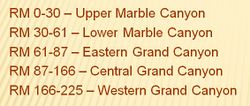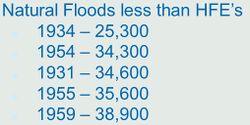Difference between revisions of "GCDAMP Flow Type Understanding"
From Glen Canyon Dam AMP
(add Flood -Diagram.jpg) |
(fix) |
||
| Line 21: | Line 21: | ||
# Experiment HFE's have not exceeded 45,000 cfs. | # Experiment HFE's have not exceeded 45,000 cfs. | ||
# | # | ||
| + | |||
| + | ---- | ||
| + | *Source: CREDA letter_2-22-2010_In the summer of 2001, experimentation cost $31 million. | ||
| + | *Source: Low Flows- CREDA web-site- Glen Canyon Dam “In April 2000, it was determined that due to hydrologic conditions and resulting from a 1994 USFW biological opinion, a low flow summer experiment would be undertaken. High spike flows in May and September, with low flat flows (8,000 cfs) all summer. The purpose was to gain information about HBC conditions. The low, flat flows had a severe impact on power generation, requiring WAPA to purchase replacement power on the open market in order to meet contractual obligations to the CRSP customers. The cost of the replacement power was over $22 million. | ||
Revision as of 11:56, 31 October 2012
- NPS-USBR-USGS_Frequently Asked Questions- High Flow Expiriments
- Main Factors in prescribing a controlled flood release: 1. Magnitued 2. Duration 3. frequency 4. Timing
- Research Flows (RF) : Flows involving violent diurnal changes in water releases from Glen Canyon Dam, which largely prevented natural reproduction of rainbow trout but apparently did not cause low recruitments of downstream native fishes. (Like in the 1980's)
- Modified Low Fluctuating Flows (MLFF) : aimed at reducing durnal variation in flows so as to reduce sand export rates, improve flow conditions for recreational boating, and provide more hospitable flow conditions for both juvenile rainbow trout and native fishes.
- Beach Habitat Building Flows (BHBF) : flows aimed at moving sand from the river channel and eddy environments to beach habitats. (maximum powerplant capacity plus full bypass have been called BHBFs)
- Low Summer Steady Flows (LSSF) : Flows aaimed at improving survival of juvenile native fishes in the mainstem, particularly through warming of backwater and nearshore environments of the CR mainstem (2000)
- Fall Steady Flows : flows in a fall period (September- October) thought to be critical for juvenile survival of humpback chub.
- Seasonally Adjusted Steady Flows (SASF) : Flows aimed at eliminating negative effects of diurnal flow variation on aquatic biota and providing a more natural seasonal hydrograph pattern.
- Load Following Flows (LFF) : Flows that fluctuate to respond to hydropower loads. (1980's) ecological and recreational rafting concerns.
- Fish Supression Flows : Rapid downramping of flows in summer, possibly preceded by periods of high steady flows, aimed at increasing stranding and mortality of juvenile rainbow trout in the Lees Ferry reach.
High Flow Experiment
- (Source: 63rd annual report 9-30-2011_Upper Colorado River Commission)
- Since the damming of the river in 1963, there has been only one flow relrease that approached average pre-dam spring floods 1983.
- Experiment HFE's have not exceeded 45,000 cfs.
- Source: CREDA letter_2-22-2010_In the summer of 2001, experimentation cost $31 million.
- Source: Low Flows- CREDA web-site- Glen Canyon Dam “In April 2000, it was determined that due to hydrologic conditions and resulting from a 1994 USFW biological opinion, a low flow summer experiment would be undertaken. High spike flows in May and September, with low flat flows (8,000 cfs) all summer. The purpose was to gain information about HBC conditions. The low, flat flows had a severe impact on power generation, requiring WAPA to purchase replacement power on the open market in order to meet contractual obligations to the CRSP customers. The cost of the replacement power was over $22 million.


